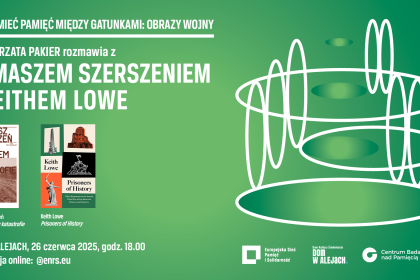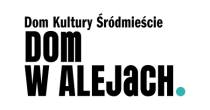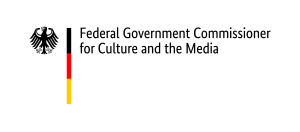Walking down the street you see: a monument commemorating fighting soldiers, a plaque commemorating murdered civilians, a billboard with a propaganda slogan. A newspaper with a photograph from the front lies on the street, someone has sent you a new meme with Putin, you are watching a recording from the trenches.
Culture reacts to catastrophe in different ways: sometimes it can distort it, sometimes it helps us understand it. The 80th anniversary of the end of World War II is a moment to reflect on what images of war we see every day and whether they talk about the past - and the present - in a responsible, accurate and important way.
We invite you to join the conversation with Keith Lowe, historian and author of Prisoners of History, which explores the monuments that shape our memory of World War II, and Tomasz Szerszeń, essayist and author of Being a Guest in a Catastrophe, a reflection on the visual language of war in Ukraine.
The meeting will take place at Dom w Alejach in Warsaw, 26 June 2025, at 6:00 p.m.
The meeting will be held in English with simultaneous Polish translation and broadcast online on the ENRS Facebook account.
Monument reflect our values, and every society deceives itself that its values are eternal: it is for this reason that we cast those values in stone and set them upon a pedestal. But when the world changes, our monuments – and the values that they represent – remain frozen in time.
Prisoners of History Keith Lowe
A strange feeling that the longer this war lasts and the more of its images accumulate, the less of them reach us. It is as if the media have accustomed themselves and us to these terrible sights. The iconography of war is becoming tiresome, becoming a return to the same old thing.
Being a Guest in a Catastrophe Tomasz Szerszeń
Keith Lowe, British historian and author of Prisoners of History: What Monuments to World War II Tell Us About Our History and Ourselves. In his book, he examines 25 monuments from 16 countries that tell the story of war through the prism of heroes, victims, monsters, apocalypse and rebirth. He shows how monuments become political actors of memory – and how they can block our ability to think critically about the past.
Tomasz Szerszeń, Polish essayist, anthropologist, author of the book Being a Guest in a Catastrophe. His starting point is the question: what do we really see when we look at war? In his publication, he tries to tell the story of war through art and visuality, maneuvering between research distance and affective engagement.
Małgorzata Pakier, is the host of the discussion and the head of the Academic Department at the European Network Remembrance and Solidarity. She is the co-creator of the Genealogies of Memory project and the creator of the To Understand Memory series and an alumna of Polish School of Reportage.
_____________________________________
Czy znużyło Ci się patrzenie na wojnę?
Idąc ulicą widzisz: pomnik walczących żołnierzy, tablicę przypominającą o rozstrzelanych cywilach, bilbord z hasłem propagandowym. Na ulicy leży gazeta z fotografią z frontu, ktoś ci wysłał nowy mem z Putinem, oglądasz nagranie z okopów.
Kultura w różny sposób reaguje na katastrofę: czasami może ją zniekształcić, czasami pomaga nam ją zrozumieć. Osiemdziesiąta rocznica zakończenia II wojny światowej to moment na refleksję nad tym, jakie obrazy wojny widzimy na co dzień i czy w sposób odpowiedzialny, trafny i ważny opowiadają one o przeszłości - i teraźniejszości.
Zapraszamy do dołączenia do rozmowy z Keithem Lowem, historykiem piszącym o pomnikach opowiadających historię II wojny światowej (Prisoners of History), oraz Tomaszem Szerszeniem, eseistą piszącym o wizualności wojny w Ukrainie (Być gościem w katastrofie).
Spotkanie odbędzie się w Domu w Alejach w Warszawie, 26 czerwca o godz. 18:00.
Spotkanie odbędzie się w języku angielskim z polskim tłumaczeniem symultanicznym i transmisją online na profilu ENRS na Facebooku w języku angielskim.
Pomniki odzwierciedlają nasze wartości, a każde społeczeństwo oszukuje się, że to jego wartości są wieczne: z tego powodu odlewamy je w kamieniu i stawiamy je na piedestale. Ale gdy świat się zmienia, nasze pomniki – i wartości, które reprezentują – pozostają zamrożone w czasie.
Prisoners of History Keith Lowe
Dziwne poczucie, że im dłużej trwa ta wojna i im więcej jej obrazów się nawarstwia, tym mniej z nich do nas dociera. Tak, jakby media przyzwyczaiły siebie i nas to tych strasznych widoków. Ikonografia wojenna zaczyna nużyć, staje się powrotem do tego samego.
Być gościem w katastrofie Tomasz Szerszeń
Keith Lowe, brytyjski historyk i autor książki Prisoners of History: What Monuments to World War II Tell Us About Our History and Ourselves. W swojej książce przygląda się 25 pomnikom z 16 krajów, które opowiadają o wojnie przez pryzmat bohaterów, ofiar, potworów, apokalipsy i odrodzenia. Pokazuje, jak pomniki stają się politycznymi aktorami pamięci – i jak potrafią zablokować naszą zdolność do krytycznego myślenia o przeszłości.
Tomasz Szerszeń, polski eseista, antropolog, autor książki Być gościem w katastrofie. Punktem wyjścia jest dla niego pytanie: co naprawdę widzimy, gdy patrzymy na wojnę. W swojej publikacji próbuje opowiedzieć o wojnie przez sztukę i wizualność, lawirując między badawczym dystansem a afektywnym zaangażowaniem.
Małgorzata Pakier, jest prowadzącą spotkanie i kieruje działem naukowym w Europejskiej Sieci Pamięć i Solidarność, jest współtwórczynią projektu Genealogie Pamięci, pomysłodawczynią projektu Zrozumieć Pamięć i absolwentką Polskiej Szkoły Reportażu.











